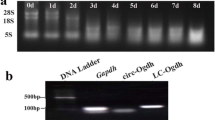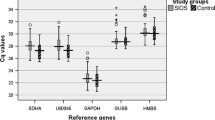Abstract
In forensic molecular pathology, quantitative real-time polymerase chain reaction (RT-qPCR) provides a rapid and sensitive method to investigate functional changes in the death process. Accurate and reliable relative RT-qPCR requires ideal amplification efficiencies of target and reference genes. However, the amplification efficiency, changing during PCR, may be overestimated by the traditional standard curve method. No single gene meets the criteria of an ideal endogenous reference. Therefore, it is necessary to select suitable reference genes for specific requirements. The present study evaluated 32 potential reference genes in the human brain of 15 forensic autopsy cases using three different statistical algorithms, geNorm, NormFinder, and BestKeeper. On RT-qPCR data analyses using a completely objective and noise-resistant algorithm (Real-time PCR Miner), 24 genes met standard efficiency criteria. Validation of their stability and suitability as reference genes using geNorm suggested IPO8 and POLR2A as the most stable ones, and NormFinder indicated that IPO8 and POP4 had the highest expression stabilities, while BestKeeper highlighted ABL1 and ELF1 as reference genes with the least overall variation. Combining these three algorithms suggested the genes IPO8, POLR2A, and PES1 as stable endogenous references in RT-qPCR analysis of human brain samples, with YWHAZ, PPIA, HPRT1, and TBP being the least stable ones. These findings are inconsistent with those of previous studies. Moreover, the relative stability of target and reference genes remains unknown. These observations suggest that suitable reference genes should be selected on the basis of specific requirements, experiment conditions, and the characteristics of target genes in practical applications.



Similar content being viewed by others
References
Wong ML, Medrano JF (2005) Real-time PCR for mRNA quantitation. Biotechniques 39(1):75–85
Arya M, Shergill IS, Williamson M, Gommersall L, Arya N, Patel HR (2005) Basic principles of real-time quantitative PCR. Expert Rev Mol Diagn 5(2):209–219
Kim KY, Kwon Y, Bazarragchaa M, Park AJ, Bang H, Lee WB, Lee J, Lee KH, Kim BJ, Kim K (2012) A real-time PCR-based amelogenin Y allele dropout assessment model in gender typing of degraded DNA samples. Int J Leg Med. doi:10.1007/s00414-011-0663-5
Maeda H, Zhu BL, Ishikawa T, Michiue T (2010) Forensic molecular pathology of violent deaths. Forensic Sci Int 203(1–3):83–92
Maeda H, Ishikawa T, Michiue T (2011) Forensic biochemistry for functional investigation of death: concept and practical application. Leg Med (Tokyo) 13(2):55–67
Madea B, Saukko P, Oliva A, Musshoff F (2010) Molecular pathology in forensic medicine—introduction. Forensic Sci Int 203(1–3):3–14
Zhao D, Ishikawa T, Quan L, Li DR, Michiue T, Yoshida C, Komatu A, Chen JH, Zhu BL, Maeda H (2008) Tissue-specific differences in mRNA quantification of glucose transporter 1 and vascular endothelial growth factor with special regard to death investigations of fatal injuries. Forensic Sci Int 177(2–3):176–183
Wang Q, Ishikawa T, Michiue T, Zhu BL, Guan DW, Maeda H (2012) Intrapulmonary aquaporin-5 expression as a possible biomarker for discriminating smothering and choking from sudden cardiac death: a pilot study. Forensic Sci Int 220(1–3):154–157
Iino M, Nakatome M, Ogura Y, Fujimura H, Kuroki H, Inoue H, Ino Y, Fujii T, Terao T, Matoba R (2003) Real-time PCR quantitation of FE65 a beta-amyloid precursor protein-binding protein after traumatic brain injury in rats. Int J Leg Med 117(3):153–159
Nolan T, Hands RE, Bustin SA (2006) Quantification of mRNA using real-time RT-PCR. Nat Protoc 1(3):1559–1582
Miyazato T, Ishikawa T, Michiue T, Maeda H (2012) Molecular pathology of pulmonary surfactants and cytokines in drowning compared with other asphyxiation and fatal hypothermia. Int J Leg Med 126(4):581–587
Zhao D, Zhu BL, Ishikawa T, Quan L, Li DR, Maeda H (2006) Real-time RT-PCR quantitative assays and postmortem degradation profiles of erythropoietin, vascular endothelial growth factor and hypoxia-inducible factor 1 alpha mRNA transcripts in forensic autopsy materials. Leg Med (Tokyo) 8(2):132–136
Chen JH, Michiue T, Ishikawa T, Maeda H (2012) Molecular pathology of natriuretic peptides in the myocardium with special regard to fatal intoxication, hypothermia, and hyperthermia. Int J Leg Med 126(5):747–756
Wang Q, Ishikawa T, Michiue T, Zhu BL, Guan DW, Maeda H (2012) Molecular pathology of pulmonary edema after injury in forensic autopsy cases. Int J Leg Med. doi:10.1007/s00414-012-0758-7
Pfaffl MW (2001) A new mathematical model for relative quantification in real-time RT-PCR. Nucleic Acids Res 29(9):e45
Wittwer C, Hahn M, Kaul K (2004) Rapid cycle real-time PCR: methods and applications: quantification. Springer, Berlin
Liu W, Saint DA (2002) A new quantitative method of real time reverse transcription polymerase chain reaction assay based on simulation of polymerase chain reaction kinetics. Anal Biochem 302(1):52–59
Tichopad A, Dilger M, Schwarz G, Pfaffl MW (2003) Standardized determination of real-time PCR efficiency from a single reaction set-up. Nucleic Acids Res 31(20):e122
Liu W, Saint DA (2002) Validation of a quantitative method for real time PCR kinetics. Biochem Biophys Res Commun 294(2):347–353
Harar RP, Kalan A, Kenyon GS (2002) Improving the reproducibility of acoustic rhinometry in the assessment of nasal function. ORL J Otorhinolaryngol Relat Spec 64(1):22–25
Ramakers C, Ruijter JM, Deprez RH, Moorman AF (2003) Assumption-free analysis of quantitative real-time polymerase chain reaction (PCR) data. Neurosci Lett 339(1):62–66
Peirson SN, Butler JN, Foster RG (2003) Experimental validation of novel and conventional approaches to quantitative real-time PCR data analysis. Nucleic Acids Res 31(14):e73
Bar T, Stahlberg A, Muszta A, Kubista M (2003) Kinetic Outlier Detection (KOD) in real-time PCR. Nucleic Acids Res 31(17):e105
Zhao S, Fernald RD (2005) Comprehensive algorithm for quantitative real-time polymerase chain reaction. J Comput Biol 12(8):1047–1064
Marino JH, Cook P, Miller KS (2003) Accurate and statistically verified quantification of relative mRNA abundances using SYBR Green I and real-time RT-PCR. J Immunol Methods 283(1–2):291–306
de Jonge HJ, Fehrmann RS, de Bont ES, Hofstra RM, Gerbens F, Kamps WA, de Vries EG, van der Zee AG, te Meerman GJ, ter Elst A (2007) Evidence based selection of housekeeping genes. PLoS One 2(9):e898
Tomita H, Vawter MP, Walsh DM, Evans SJ, Choudary PV, Li J, Overman KM, Atz ME, Myers RM, Jones EG, Watson SJ, Akil H, Bunney WE Jr (2004) Effect of agonal and postmortem factors on gene expression profile: quality control in microarray analyses of postmortem human brain. Biol Psychiatry 55(4):346–352
Vandesompele J, De Preter K, Pattyn F, Poppe B, Van Roy N, De Paepe A, Speleman F (2002) Accurate normalization of real-time quantitative RT-PCR data by geometric averaging of multiple internal control genes. Genome Biol 3(7):RESEARCH0034
Andersen CL, Jensen JL, Orntoft TF (2004) Normalization of real-time quantitative reverse transcription-PCR data: a model-based variance estimation approach to identify genes suited for normalization, applied to bladder and colon cancer data sets. Cancer Res 64(15):5245–5250
Pfaffl MW, Tichopad A, Prgomet C, Neuvians TP (2004) Determination of stable housekeeping genes, differentially regulated target genes and sample integrity: BestKeeper—Excel-based tool using pair-wise correlations. Biotechnol Lett 26(6):509–515
Zipes DP, Wellens HJ (1998) Sudden cardiac death. Circulation 98(21):2334–2351
Wang Q, Ishikawa T, Michiue T, Zhu BL, Guan DW, Maeda H (2012) Quantitative immunohistochemical analysis of human brain basic fibroblast growth factor, glial fibrillary acidic protein and single-stranded DNA expressions following traumatic brain injury. Forensic Sci Int 221(1–3):142–151
Pfister C, Tatabiga MS, Roser F (2011) Selection of suitable reference genes for quantitative real-time polymerase chain reaction in human meningiomas and arachnoidea. BMC Res Notes 4:275
Coulson DT, Brockbank S, Quinn JG, Murphy S, Ravid R, Irvine GB, Johnston JA (2008) Identification of valid reference genes for the normalization of RT qPCR gene expression data in human brain tissue. BMC Mol Biol 9:46
Koppelkamm A, Vennemann B, Fracasso T, Lutz-Bonengel S, Schmidt U, Heinrich M (2010) Validation of adequate endogenous reference genes for the normalisation of qPCR gene expression data in human post mortem tissue. Int J Leg Med 124(5):371–380
Penna I, Vella S, Gigoni A, Russo C, Cancedda R, Pagano A (2011) Selection of candidate housekeeping genes for normalization in human postmortem brain samples. Int J Mol Sci 12(9):5461–5470
Fleige S, Pfaffl MW (2006) RNA integrity and the effect on the real-time qRT-PCR performance. Mol Aspects Med 27(2–3):126–139
Koppelkamm A, Vennemann B, Lutz-Bonengel S, Fracasso T, Vennemann M (2011) RNA integrity in post-mortem samples: influencing parameters and implications on RT-qPCR assays. Int J Leg Med 125(4):573–580
Stan AD, Ghose S, Gao XM, Roberts RC, Lewis-Amezcua K, Hatanpaa KJ, Tamminga CA (2006) Human postmortem tissue: what quality markers matter? Brain Res 1123(1):1–11
Gibson UE, Heid CA, Williams PM (1996) A novel method for real time quantitative RT-PCR. Genome Res 6(10):995–1001
Arikawa E, Yang J (2007) Comparing algorithms for calculating amplification efficiencies of real-time PCR. Cambridge Healthtech Institute’s Third Annual Quantitative PCR, Microarrays, and Biological Validation: Capturing the Complete Biological Story, Providence
Graeber K, Linkies A, Wood AT, Leubner-Metzger G (2011) A guideline to family-wide comparative state-of-the-art quantitative RT-PCR analysis exemplified with a Brassicaceae cross-species seed germination case study. Plant Cell 23(6):2045–2063
Maroufi A, Van Bockstaele E, De Loose M (2010) Validation of reference genes for gene expression analysis in chicory (Cichorium intybus) using quantitative real-time PCR. BMC Mol Biol 11:15
Condori J, Nopo-Olazabal C, Medrano G, Medina-Bolivar F (2011) Selection of reference genes for qPCR in hairy root cultures of peanut. BMC Res Notes 4:392
Scharlaken B, de Graaf DC, Goossens K, Brunain M, Peelman LJ, Jacobs FJ (2008) Reference gene selection for insect expression studies using quantitative real-time PCR: the head of the honeybee, Apis mellifera, after a bacterial challenge. J Insect Sci 8:33
Weickert CS, Sheedy D, Rothmond DA, Dedova I, Fung S, Garrick T, Wong J, Harding AJ, Sivagnanansundaram S, Hunt C, Duncan C, Sundqvist N, Tsai SY, Anand J, Draganic D, Harper C (2010) Selection of reference gene expression in a schizophrenia brain cohort. Aust N Z J Psychiatry 44(1):59–70
Tunbridge EM, Eastwood SL, Harrison PJ (2011) Changed relative to what? Housekeeping genes and normalization strategies in human brain gene expression studies. Biol Psychiatry 69(2):173–179
Bustin SA, Beaulieu JF, Huggett J, Jaggi R, Kibenge FS, Olsvik PA, Penning LC, Toegel S (2010) MIQE precis: practical implementation of minimum standard guidelines for fluorescence-based quantitative real-time PCR experiments. BMC Mol Biol 11:74
Bustin SA, Benes V, Garson JA, Hellemans J, Huggett J, Kubista M, Mueller R, Nolan T, Pfaffl MW, Shipley GL, Vandesompele J, Wittwer CT (2009) The MIQE guidelines: minimum information for publication of quantitative real-time PCR experiments. Clin Chem 55(4):611–622
Acknowledgments
This study was supported in part by a Grant-in-Aid for Scientific Research from the Japan Society for the Promotion of Science and the Ministry of Education, Culture, Sports, Science, and Technology, Japan (grant no. 22590642).
Author information
Authors and Affiliations
Corresponding author
Electronic supplementary material
Below is the link to the electronic supplementary material.
Supplementary Material 1
Introduction of candidate reference genes (n = 32). “_s” suffix indicates the assay’s primers and probes are designed within a single exon and will detect genomic DNA. “_m” indicates the assay’s probe spans an exon junction and will not detect genomic DNA. “_g” indicates the assay may detect genomic DNA. The “context sequence” is the nucleotide sequence surrounding the region to which the probe binds. Primer and probe sequences for TaqMan assays are not available. Detailed information for each TaqMan Assay is available from Applied Biosystems. (PPT 121 kb)
Supplementary Material 2
Linear regression between RIN and relative non-normalized quantities of candidate reference genes. Genes with significant correlations with RIN are shown in bold. RIN, RNA integrity number; R 2, coefficients of determination; b0, the intercept of the regression line with the y-axis; b1, the slope of the regression line. (PPT 114 kb)
Supplementary Material 3
Pearson correlation coefficients (R 2) between relative non-normalized quantities of each pair of candidate reference genes. (XLS 52 kb)
Rights and permissions
About this article
Cite this article
Wang, Q., Ishikawa, T., Michiue, T. et al. Stability of endogenous reference genes in postmortem human brains for normalization of quantitative real-time PCR data: comprehensive evaluation using geNorm, NormFinder, and BestKeeper. Int J Legal Med 126, 943–952 (2012). https://doi.org/10.1007/s00414-012-0774-7
Received:
Accepted:
Published:
Issue Date:
DOI: https://doi.org/10.1007/s00414-012-0774-7




